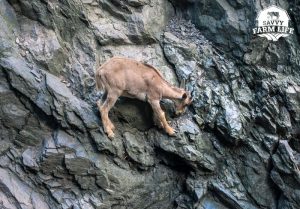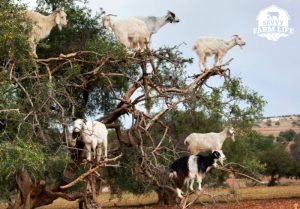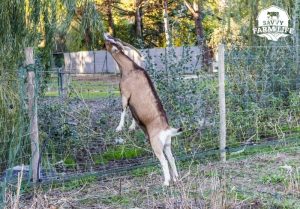
Why Are Goats Such Good Climbers?
Goats are fascinating animals, and are second to none when it comes to climbing. While many goats are content to remain on the ground, some goats will test you by climbing onto a fence post, up a tree, or even onto a roof. Ive even seen a goat walk and balance along a fence board like a cat would!
How is it that goats can climb almost anything? A goat’s ability to climb comes down to their physiology; their muscular necks and shoulders help them to balance while their cloven feet enables them to distribute their weight and grip onto surfaces. Combined with their jumping abilities, it is no wonder you can find goats, both wild and domestic, in the most curious of places.
If you have just purchased goats or you’re looking to get goats, you should definitely be aware of their ability to climb, as this is one of the reasons goats are known as notorious escape artists. Read on to learn more about a goat’s climbing ability and what you can do to deter goats from escaping their pen!
What Is It That Makes Goats So Good At Climbing?
Goats are able to climb structures that humans couldn’t dream of climbing, and it all comes down to physiology. Goats use both their muscular shoulders and their muscular necks to help them maintain balance in precarious situations, and they also have lean bodies that allow them the grace to get themselves into those situations. But the real magic is in the hooves.
Goat Feet Are Designed To Climb
As long as a goat can find a ledge of at least a 2-inch protrusion, he can climb. Goats have two large toes on each foot that they can spread out to find footing. Think about our own feet – if we are trying to maintain our balance, we will spread our toes out as much as possible. This not only allows us to maintain more contact with the ground, but it also allows our weight to be evenly balanced. The goat’s two large toes work in the same way – by spreading them out, they can maintain contact with a larger area of ground (or rock), and distribute their weight more efficiently.
Goat Hoof Anatomy
 In addition to these two large toes, goats also have two vestigial toes on each foot – these are two smaller toes higher up on the leg, and are often called “dewclaws”. Goats can make use of these vestigial toes to balance and grip as well, allowing them even greater control and security when climbing.
In addition to these two large toes, goats also have two vestigial toes on each foot – these are two smaller toes higher up on the leg, and are often called “dewclaws”. Goats can make use of these vestigial toes to balance and grip as well, allowing them even greater control and security when climbing.
These toes are not the only advantage that goat hooves have when it comes to climbing. Goats hooves have a hard outer shell with a pointed tip – allowing them to find even the smallest niches to grab on to and grip while climbing. Moving beyond the hard outer shell, the pads of a goat’s hooves are soft and padded. This allows the goat’s foot pad to shape itself around a ledge or foothold – providing excellent grip and traction. Between this hard outer shell and the soft, contoured pad, it is easy to see how goats are able to climb almost anything.
Goats: The Original Mountain Climbers
Goats are prey animals, and have few natural defenses at their disposal. Yes, they can run and they can kick, but when faced with a mountain lion or a pack of wolves, goats are quite vulnerable. To give them an edge against predators, mountain goats have evolved into jumping, climbing machines. These abilities allow them to escape predators by climbing cliff faces and ravines that few other animals can reach. It is not uncommon to see a mountain goat climbing at an elevation of up to 13,000 feet.
Mountain goats are native to North America – found in the mountain ranges of the United States and Canada. Their predators in these regions include mountain lions, wolves, and bears. While some of these predators are themselves adept at climbing, they are no match for their goat prey. Climbing mountains and cliffs is a means of survival for mountain goats, and kids (baby goats) are expected to begin climbing when they are as young as 24 hours old.
While the goats we know as mountain goats are confined to North America, these are not the only mountain-climbing wild goats. Around the world you can find wild goats climbing mountains, from Russia to Afghanistan. In fact, the mountain-climbing goats found in Asia were the first to become domesticated by humans thousands of years ago.
Do Mountain Goats Ever Fall When Climbing?
 Goats are extremely agile and graceful. But this does not make them immune to stumbles – especially for the very young goats and elderly goats. A stumble for most of us is rarely cause for alarm – but a stumble from a cliff face hundreds of feet above the ground is.
Goats are extremely agile and graceful. But this does not make them immune to stumbles – especially for the very young goats and elderly goats. A stumble for most of us is rarely cause for alarm – but a stumble from a cliff face hundreds of feet above the ground is.
Some researchers estimate that more goat deaths are caused by falls than by predators. So while a mountain goat is able to successfully evade predators by climbing, this does not always put them out of harm’s way. Goats may lose their balance and fall to their deaths, occasionally taking others with them on their way down.
Still, climbing treacherous terrain has saved many more goat lives than it has taken, which is why a goat will always prefer to stay above its natural predators then at eye level.
Did You Know That Goats Can Climb Trees?
Mountain goats are not the only wild goats that use climbing as a way to survive. Goats in all regions use climbing as a way of finding food, particularly in areas with sparse vegetation. In fact, if you visit Morocco you are bound to find herds of goats climbing the Argan trees – munching on leaves and sitting in slim branches up to 30 feet tall.
Goats Not Only Excel At Climbing, But Also At Jumping
Not only are goats exceptional climbers, but they are also impressive jumpers. Goats can jump as far as 12 feet in a single leap. Combining the skill of jumping with the ability to climb, goats can reach almost anything their hearts desire. It is no wonder that goats are notorious for escaping enclosures. Goats can climb an endless number of structures – including mountains, fences, ladders, or even brick walls. You may find a goat halfway up an old oak tree, or on top of a barn roof.
To learn more about why goats jump, visit my article Why Do Goats Jump? Goat Jumping Behavior Guide.
How to Keep Goats From Climbing Out of Their Enclosure
Goats are fun to watch, with their affable personalities and curious natures. But that curious nature can often get them into trouble too, especially when they are so good at climbing. I can’t tell you how many times I’ve had to deal with escaped goats, whether while I was farm-sitting for someone or my own goats managed to get out! Here are some ways you can keep your goats from climbing or jumping out of their pens:
Put an Electric Tape Over The Fence
Many goat keepers use electric tape to prevent their goats from escaping, as this is often one of the only ways to keep a goat confined. By putting electric tape over the fence and at the bottom of the fence, this will keep goats from both jumping or climbing over or crawling out.
Keep Climbing Structures Away From the Fence
It is also advised that you not have any structures erected near your fences – these will only serve as jumping-off points for your curious goats. I farm-sat once at a place the goats kept escaping. I ended up sitting outside to see how exactly they were doing it and, lo and behold, I watched as they jumped on top of their small run-in shed and then let over the fence to the hill on the other side. As you’re setting up your goat pen, this is something to be aware of!
Keep Your Goats Entertained
 Goats are curious creatures, and one reason they may try to escape is because they are bored in their pen. By providing them with plenty of sustenance and entertainment in their enclosure, goats will be less likely to try and escape. Make sure they have fixtures to climb on and jump off of. I’ve seen people put full-size playground sets in their goat pen for the goats to enjoy!
Goats are curious creatures, and one reason they may try to escape is because they are bored in their pen. By providing them with plenty of sustenance and entertainment in their enclosure, goats will be less likely to try and escape. Make sure they have fixtures to climb on and jump off of. I’ve seen people put full-size playground sets in their goat pen for the goats to enjoy!
Another thing you’ll want to do is make sure your goat has access to adequate forage, whether you’re feeding hay or they have a grazing/browsing area. Goats are designed to be eating for the majority of the day, so if there is no food to munch on, it can leave them with nothing to do.
To learn more about what to put in your goat enclosure, visit my article What Goats Need In Their Pen: Complete List.
Which Breeds Of Goats Climb Most?
All goats have climbing and jumping in their genetics, and for the most part, the breed will not make much of a difference. Whether or not your goat will be a climbing machine will come down to your goat’s individual personality.
It has been noted that one breed that does not seem as interested in escaping enclosures is the myotonic goat breed. These are the goats made famous for their “fainting” spells when frightened. Myotonic goats are known to be easy keepers and are not (usually) as prone to climbing and jumping.
While not always the case, many believe that the larger goat breeds tend to stay more “grounded” than the smaller goat breeds. Smaller breeds may find it easier to jump and climb than their larger-framed cousins.
Why Domestic Goats Love Climbing
It is easy to understand why wild goats are such proficient climbers – it is a survival tactic. But why do our domestic goats love climbing as much as they do? Climbing is in the goat’s genetics, and with their athletic, muscular bodies, it is something they enjoy doing. Combine their physical prowess with their curious, gregarious personalities, and you have a recipe for a climbing, jumping, fun-loving goat!
Another weird thing goats do is scream. We’ve all seen the video of Taylor Swift and the screaming goat, right? Well, to know more about why goats scream, visit my article Why Do Goats Scream? Goat Behavior Guide.
